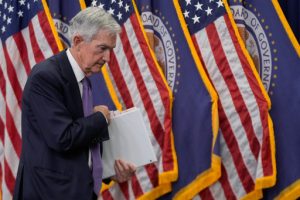WASHINGTON
By DAVID KLEPPER, ERIC TUCKER and CHRIS MEGERIANAssociated Press
A leaked intelligence memo contradicting President Donald Trump’s assessment of recent U.S. strikes on Iran is just the latest conflict with a part of the federal government that Trump has viewed with deep suspicion. Trump’s distrust of the intelligence community goes back to before his first term when questions were raised about his campaign’s alleged ties to Russia. So far in his second term, he’s tapped loyalists to lead the CIA and other intel agencies and has publicly dismissed intelligence assessments that undercut his claims. Former intelligence officials say spy services strive to stay out of politics and a final accounting of the strikes on Iran will take time.
WASHINGTON (AP) — President Donald Trump's fights with the intelligence community were a running theme of his first term, as he raged against an investigation into his campaign’s alleged links to Russia. Now, a sequel is playing out as Trump battles to shape the public’s understanding of his foreign policy gamble in Iran.
An early U.S. intelligence assessment said Iran’s nuclear program has been set back only a few months after American strikes on three sites last weekend. Trump has rejected the report and pronounced the program “completely and fully obliterated.”
The dispute is unlikely to fade anytime soon. Top administration officials are pressing Trump's case, with a news conference set for Thursday at the Pentagon. Briefings also are scheduled for lawmakers on Capitol Hill, though the White House plans to limit the sharing of classified information after the initial intelligence assessment leaked this week.
“Intelligence people strive to live in a world as it is, describe the world as it is, where politicians are all about describing the world as they want it to be,” said Larry Pfeiffer, a 32-year intelligence veteran who held positions including CIA chief of staff and senior director of the White House Situation Room.
Though it’s hardly unheard of for presidents to bristle at what they perceive as bad news from the intelligence community, it's rare for the conflict to spill into public view as it did this week.
“I don’t think we’ve seen another president push back as strong as this guy has,” Pfeiffer said.
Trump’s suspicion of the intelligence community, particularly when its assessments do not align with his worldview, dates back to even before his first term.
His 2016 campaign was shadowed by an investigation into whether his team had coordinated with Russia to sway the outcome of the election.
He was so infuriated by the scrutiny over a dossier of unverified and salacious claims connecting him to Russia that, one week before he was sworn in, he tweeted: “Intelligence agencies should never have allowed this fake news to ‘leak’ into the public. One last shot at me. Are we living in Nazi Germany?”
Trump disputed the assessment that Russia had interfered in the election on his behalf, decrying as a “hoax” and a “witch hunt” an investigation by special counsel Robert Mueller, which ultimately concluded the Trump campaign had welcomed Moscow’s help but did not find sufficient evidence of a criminal conspiracy.
Trump also openly challenged the judgment of his intelligence agencies alongside Russian President Vladimir Putin at a Helsinki summit in 2018.
“I have great confidence in my intelligence people, but I will tell you that President Putin was extremely strong and powerful in his denial today,” Trump said. “He just said it’s not Russia. I will say this: I don’t see any reason why it would be.”
Such public protestation takes its toll on an intelligence community that historically has endeavored to produce data-driven and apolitical judgments, said Frank Montoya Jr., a former FBI supervisor who served as director of the National Counterintelligence and Security Center.
“It’s really demoralizing because nobody is looking at this stuff from a political perspective. They’re looking at the data and they’re analyzing the data,” he said. “When you get this kind of unfounded criticism, especially from the policymaker in chief, it just destroys morale.”
Trump tapped loyalists to lead America's intelligence services in his second term — Tulsi Gabbard as director of national intelligence and John Ratcliffe as CIA director. They promised to end what they said was the weaponization of intelligence and root out disloyal officers.
But there have already been conflicts.
Last month, the National Intelligence Council declassified a memo in response to an open records request that said American spy agencies found no coordination between the Venezuelan government and the Tren de Aragua gang, contradicting statements the Trump administration used to justify invoking the Alien Enemies Act and deporting Venezuelan immigrants.
Gabbard later fired the two veteran intelligence officers who led the council because of their perceived opposition to Trump.
More trouble came after the war between Israel and Iran began nearly two weeks ago.
Trump dismissed Gabbard's testimony to Congress in March that U.S. spy agencies did not believe Iran was actively pursuing a nuclear weapon. Trump insisted Iran was very close.
“I don't care what she said,” he told reporters last week.
Gabbard later accused the news media of mischaracterizing her testimony, noting that she had mentioned Iran's large stockpile of enriched uranium that goes beyond levels needed for civilian uses.
Iran maintains that its nuclear program was peaceful, though the head of the International Atomic Energy Agency has repeatedly warned that Tehran has enough highly enriched uranium to make several nuclear bombs if it chooses.
A preliminary report from the Defense Intelligence Agency that emerged this week said that while the U.S. strikes on Iranian nuclear facilities did significant damage, the facilities were not totally destroyed and the program was only set back by a few months.
The White House called the assessment “flat-out wrong.” The DIA said the initial findings will be refined as new information becomes available.
Given Trump’s skeptical view of intelligence officials, Pfeiffer said, “his initial instinct is to assume that if the intelligence community is telling him something different than he would like it to be, that it’s because they’re trying to undermine him.”
Gabbard and Ratcliffe have sought to brush off any perceived conflict between their agencies and Trump. Ratcliffe said Wednesday that new intelligence from a “historically reliable and accurate” source reveals that U.S. strikes “destroyed” several of Iran’s nuclear facilities that would require years to be rebuilt.
“CIA continues to collect additional reliably sourced information to keep appropriate decision-makers and oversight bodies fully informed,” Ratcliffe said in a statement. “When possible, we will also provide updates and information to the American public, given the national importance of this matter and in every attempt to provide transparency.”
Gabbard noted the DIA assessment was of “low confidence,” an acknowledgment by its authors that their conclusions could be mistaken.
“The propaganda media has deployed their usual tactic: selectively release portions of illegally leaked classified intelligence assessments,” she wrote on X.
Trump narrated his own intelligence assessment while attending the NATO summit in the Netherlands. He mentioned satellite images showing the area around nuclear facilities “burned black” and said the underground tunnels had “all collapsed.”
He also suggested Israel had sources on the ground in Iran: “They have guys that go in there after the hit” to evaluate the damage.
The White House pointed to an Israel Atomic Energy Commission assessment that the U.S. and Israeli strikes have “set back Iran’s ability to develop nuclear weapons by many years.”
Intelligence officers routinely craft assessments about global threats and specific incidents — information vital to the decision-making of national security officials and lawmakers. Assessments are regularly updated as new intelligence is produced from sources including field agents, informants, open source material and secret surveillance.
The work is secretive to protect the methods and sources of intelligence agencies and to avoid becoming a political football.
Former intelligence officials said it's likely to take days, weeks, or even months to form a full picture of the impact of the U.S. strikes on Iran's nuclear capabilities.
“I would call for patience,” said John Negroponte, a former ambassador who served as the first director of national intelligence under President George W. Bush. “Avoid the temptation to rush to judgment.”
___
Associated Press writer Aamer Madhani contributed to this report.





